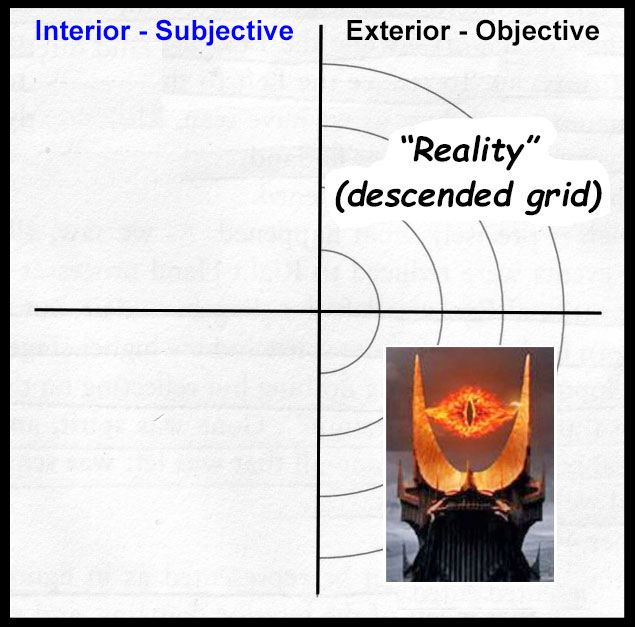The Postmodern Watershed The old paradigm that everybody doesn’t want is the Enlightenment paradigm, which is also called the modern paradigm. It has dozens of other names, all pronounced with scorn and disgust: the Newtonian, the Cartesian, the mechanistic, the mirror of nature, the reflection paradigm. The fundamental Enlightenment paradigm is known as the representation paradigm – the idea that you have the self or the subject, on the one hand, and the empirical or sensory world, on the other. And all valid knowledge consists in making maps of the empirical world. If the map is accurate and correctly represents the empirical world then that is “Truth”. The map could be an actual map, or a theory, or a hypothesis, or an idea, or a table, or a concept, or some sort of representation – in general, some sort of map of the objective world. Representation paradigm is not wrong. It’s just very narrow and very limited. The difficulties of the representation paradigm are rather subtle, and it took a very long time several centuries, actually – to realize what the problem was. The simplest way to state the problem with maps that they leave out the mapmaker. What was being utterly ignored was the fact that the mapmaker might itself bring something to the picture! All “post-Enlightenment” or “postmodern” parties agreed that this “mirror of nature” idea was massively naive. Beginning especially with Kant, and running through Hegel, Schopenhauer, Nietzsche, Dilthey, Heidegger, Foucault, Derrida – all the great postmodern theorists. The self did not just parachute to earth. So, the great postmodern discovery was that neither the self nor the world is simply pregiven, but rather they exist in the contexts and backgrounds that have a history, a development. The subject will picture the world based in many ways on what the subject itself brings to the picture. Hegel champions the crucial point that defines all postmodern theories: the mind, the subject, can “only be conceived as one that has developed.” And one way or another, all postmodern roads lead to Nietzsche. Scientism The ‘narrow-view’ scientific map maker can be metaphor for ‘scientism’, where the incredibly powerful methods for obtaining reliable knowledge about the universe and of understanding the laws of nature (ie, Newton's laws of motion and gravity) became an arrogant power or in the words of Paul Gross and Norman Levitt ('Higher Superstition: the Academic Left & Its Quarrels With Science', 1994) an “occupational disease among scientists” who pursued not only its own truths, but to aggressively deny that there were any other truths at all. (sidenote: Gross & Levitt does inform the reader there does exist a generous complement of academics who are left-leaning, rational, and not inclined to quarrel with science). Wilber cautions that the ‘scientism’ agenda has true, unwelcomed consequences – that there is no real Spirit, there is no real mind, there is only empirical nature – otherwise what Wilber calls ‘flatland’ or the descended grid (all quads to the right plane). Flatland rejects transcendence altogether. The hatred of transcendence is the way descended grid reproduces itself in the consciousness of those it is destroying.
The term ‘humanities’ rose out of American efforts against the claim that the natural sciences are the basis for all true knowledge. Later, the so-call ‘Science Wars’ arose: the ‘artistic-humanistic’ worldview verses the ‘scientific-reductionistic’ worldview. That hostility resulted in the humanities appearing to take a negative view of science and industrialization. The ‘romantic artist’ points to the uglification of cities, the degradation of the poor, the sensationalism of the penny press, the cheapening of taste through crude mass production, the raucousness of advertising and the emotional disturbances connected with the change from manual to mechanical work.
This is what Flaubert, Ruskin, Baudelaire and William Morris are all about. In American literature the depiction of despair and evil goes from Melville to Mark Twain and Henry Adams and then to Dreiser and Scott Fitzgerald. The Golden Seat is Integral
The Golden Seat's theme is Integral – it’s grand project to integrate “Beauty, Truth & Goodness”. Similar to Wilber’s idea of ‘embrace and extend’ – to take the very best of the ancient wisdom and combine that with the very best of modernity. To reject the ‘bogus’ and embrace the ‘genuine’ (eg, genuine religion & genuine science trumps bogus religion & bogus science). Modern science rose out of the ‘Age of Reason’
or the ‘Age of Enlightenment’ out of which society benefited from:
In the ‘Zen & the Art of Motorcycle Maintenance’ (1974) author Robert Pirsig presents two ‘qualities’ of human understanding: Classical and Romantic. Classical – Square, overall understanding. Sees the world primarily as underlying form itself (engine, mechanical drawing, electronic schematic). Function. Proceeds by reason and laws (science). Sometime associated with the Masculine Mode (Solar). The classic style is straightforward, unadorned, unemotional, economical and carefully proportioned. Its purpose is not to inspire emotionally, but to bring order out of chaos and make the unknown known. It is not an esthetically free and natural style. It is esthetically restrained. Everything is under control. To the romantic the classical mode often appears dull, awkward and ugly, like mechanical maintenance itself. Everything is in terms of pieces and parts and components and relationships. Everything’s got to be measured and proved. Oppressive. Heavy. Endlessly grey. The death force. Romantic – Hip, visual. Sees the world primarily in terms of immediate appearance. The reality is the surface. Form. Inspirational, imaginative, creative, intuitive. Feelings rather than facts predominate (subjective). It does not proceed by reason or by laws. It proceeds by feeling, intuition and esthetic conscience. Sometimes associated with the Feminine Mode (Lunar). To the Classicalist the romantic appears as frivolous, irrational, erratic, untrustworthy, interested primarily in pleasure-seeking. Shallow. Of no substance. Often a parasite who cannot or will not carry his own weight. A real drag on society. “The trouble begins when people tend to think and feel exclusively in one mode and in doing so tend to misunderstand and underestimate what the other mode is all about. No one is willing to give up the truth as he or she sees it – two worlds growingly alienated and hateful toward each other…a house divided against itself.” z
|




